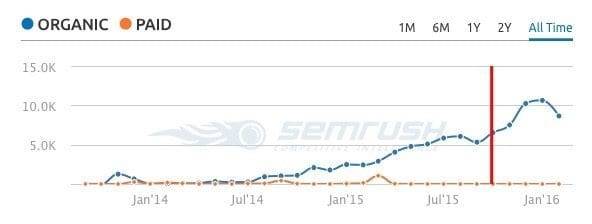The Case for Persistence in Your Online Efforts
Keep going
(Even if you aren’t getting much traction).
When you create your company website or social media pages, you’re likely to be excited at the prospect of a new flow of customers. Every industry will have its examples of start-up websites that have built up substantial traffic numbers and social followings.
In the oil and gas business, we see examples such as my favourite oil and gas industry website, Oilpro.com.
NOTE: Oilpro has since closed down for legal reasons. This was an early OOTBI blog post, and the overall message is still valid. See our ‘Goodbye Oilpro’ post here.
Here’s a graph showing a substantial increase in search visibility:

It comes from an SEO monitoring tool that I use all the time, Semrush.
Imagine that this is your website, the period from late 2013 to July 2014 might have been harsh. Around December 2013 it might have seemed like you were going backwards! But then growth roughly triples/quadruples in the last 12 months as the site takes off.
This companies website has plenty of visitors with an established audience. How do we get to this stage? Where can a new post get 10,000 views or 100 comments?
The problem is that when a website is new, it doesn’t have the necessary authority signals for the search engines to rank new content high enough for people to see it. New social media pages don’t have enough potential eyeballs on them for the viral process to take place. There needs to be a ‘critical mass’ of authority and viewers for the rich rewards to come.
Here’s the challenge:
So, between the brand new stage, and the viral stage, there’s a gulf, a wilderness, a no-mans-land of fear and anxiety. The concern is that your work will never pay off, and you’re merely wasting time and money.
Unfortunately, some of your online efforts won’t work out. We test and scale what works and abandon what doesn’t. As we progress, we develop knowledge of how our business proposition works in an online venue. We learn lessons along the way.

The majority of intrepid internet explorers get lost in this wilderness and efforts stall. The potential rewards are enormous; the mechanism for this to happen is evident to all. But how do we get through the wilderness of fear and uncertainty?
Here are a few points to consider, to help you stay focused and on track.
Sometimes it’ll feel like we’re not getting anywhere because 99% of people who see something or read something don’t take any action at all.
When you’re surfing the web, how often do you comment on a blog? How often do you see something that you enjoy on Facebook, but don’t even click the ‘like’ button? Remember that the majority of people who notice and appreciate your message won’t let you know about it.
It could be that in one or two years, a regular reader of your updates will need your product or service and will come to you. The time will be right for them. They’ll be a stranger to you, but they’ll feel like they know you already because you’ve appeared in their social media stream alongside their friends and colleagues.
Even those people who see your tweets, but don’t click on them will keep seeing your brand name, alongside a sensible comment and relevant content.
Every update, blog post, and share will help you chip away at the task of creating a brand. This process is similar to traditional advertising billboards and TV adverts. Most of them don’t have a ‘special offer’ or a telephone number to ‘call now’. Many are put off by this; these types of overt sales commercials tend to appear on tacky shopping channels.
Advertisers have realised the benefits of regular brand messages for a long time. Nowadays a commuter sat in a taxi will be likely to be looking at their smartphone, not outside at billboards.
The way that the search engines work involve an algorithm scoring system.
Googles algorithm is reported to have 200+ ranking factors. It’s prevalent for websites to ‘pop’ and take a big leap higher in the ranking. Quite often, a more established site starts ranking for hundreds of related search terms all at the same time.
To make an analogy, we all know how credit scores work. You’ll get points for how many years you’ve lived at the same address, and how many years that you’ve been with the same bank. Your score will be affected by whether you have any default records or court judgements against you for non-payment of debts and so on. All these factors add up to a score.
When you’re 16 years old, and at school, you can’t get credit. When you start work, you should be able to get a credit card and a small overdraft. After a couple of years of handling your finances well, the chances are your credit rating will ‘pop’ and you’ll be able to get a car loan and a mortgage.
This process is similar to search engine algorithms. Progress can be slow for six months to a year, possibly more. If you keep committed to your goal, at some point, your website will get established enough that Google will ‘trust’ the content that you have posted there.
Almost all of what you are doing online will have a benefit for years to come.
The editorial links that you’ve earned through doing good business will continue to link to your site and send referrals. The charts, research papers or instructional videos will get found by people that see them as helpful. That could include the next generation of clients or peers for your particular industry sub-niche.
Remember that the next generations will be far more tech-savvy. If you want your business to grow, you need to embrace future trends, even if some of them seem alien or even incomprehensible to you right now.








